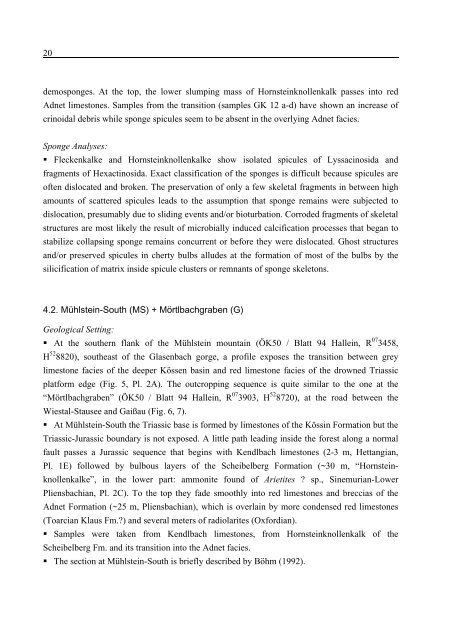Porifera-microbialites of the Lower Liassic (Northern Calcareous ...
Porifera-microbialites of the Lower Liassic (Northern Calcareous ...
Porifera-microbialites of the Lower Liassic (Northern Calcareous ...
You also want an ePaper? Increase the reach of your titles
YUMPU automatically turns print PDFs into web optimized ePapers that Google loves.
20<br />
demosponges. At <strong>the</strong> top, <strong>the</strong> lower slumping mass <strong>of</strong> Hornsteinknollenkalk passes into red<br />
Adnet limestones. Samples from <strong>the</strong> transition (samples GK 12 a-d) have shown an increase <strong>of</strong><br />
crinoidal debris while sponge spicules seem to be absent in <strong>the</strong> overlying Adnet facies.<br />
Sponge Analyses:<br />
� Fleckenkalke and Hornsteinknollenkalke show isolated spicules <strong>of</strong> Lyssacinosida and<br />
fragments <strong>of</strong> Hexactinosida. Exact classification <strong>of</strong> <strong>the</strong> sponges is difficult because spicules are<br />
<strong>of</strong>ten dislocated and broken. The preservation <strong>of</strong> only a few skeletal fragments in between high<br />
amounts <strong>of</strong> scattered spicules leads to <strong>the</strong> assumption that sponge remains were subjected to<br />
dislocation, presumably due to sliding events and/or bioturbation. Corroded fragments <strong>of</strong> skeletal<br />
structures are most likely <strong>the</strong> result <strong>of</strong> microbially induced calcification processes that began to<br />
stabilize collapsing sponge remains concurrent or before <strong>the</strong>y were dislocated. Ghost structures<br />
and/or preserved spicules in cherty bulbs alludes at <strong>the</strong> formation <strong>of</strong> most <strong>of</strong> <strong>the</strong> bulbs by <strong>the</strong><br />
silicification <strong>of</strong> matrix inside spicule clusters or remnants <strong>of</strong> sponge skeletons.<br />
4.2. Mühlstein-South (MS) + Mörtlbachgraben (G)<br />
Geological Setting:<br />
� At <strong>the</strong> sou<strong>the</strong>rn flank <strong>of</strong> <strong>the</strong> Mühlstein mountain (ÖK50 / Blatt 94 Hallein, R 07 3458,<br />
H 52 8820), sou<strong>the</strong>ast <strong>of</strong> <strong>the</strong> Glasenbach gorge, a pr<strong>of</strong>ile exposes <strong>the</strong> transition between grey<br />
limestone facies <strong>of</strong> <strong>the</strong> deeper Kössen basin and red limestone facies <strong>of</strong> <strong>the</strong> drowned Triassic<br />
platform edge (Fig. 5, Pl. 2A). The outcropping sequence is quite similar to <strong>the</strong> one at <strong>the</strong><br />
“Mörtlbachgraben” (ÖK50 / Blatt 94 Hallein, R 07 3903, H 52 8720), at <strong>the</strong> road between <strong>the</strong><br />
Wiestal-Stausee and Gaißau (Fig. 6, 7).<br />
� At Mühlstein-South <strong>the</strong> Triassic base is formed by limestones <strong>of</strong> <strong>the</strong> Kössin Formation but <strong>the</strong><br />
Triassic-Jurassic boundary is not exposed. A little path leading inside <strong>the</strong> forest along a normal<br />
fault passes a Jurassic sequence that begins with Kendlbach limestones (2-3 m, Hettangian,<br />
Pl. 1E) followed by bulbous layers <strong>of</strong> <strong>the</strong> Scheibelberg Formation (~30 m, “Hornstein-<br />
knollenkalke”, in <strong>the</strong> lower part: ammonite found <strong>of</strong> Arietites ? sp., Sinemurian-<strong>Lower</strong><br />
Pliensbachian, Pl. 2C). To <strong>the</strong> top <strong>the</strong>y fade smoothly into red limestones and breccias <strong>of</strong> <strong>the</strong><br />
Adnet Formation (~25 m, Pliensbachian), which is overlain by more condensed red limestones<br />
(Toarcian Klaus Fm.?) and several meters <strong>of</strong> radiolarites (Oxfordian).<br />
� Samples were taken from Kendlbach limestones, from Hornsteinknollenkalk <strong>of</strong> <strong>the</strong><br />
Scheibelberg Fm. and its transition into <strong>the</strong> Adnet facies.<br />
� The section at Mühlstein-South is briefly described by Böhm (1992).

















